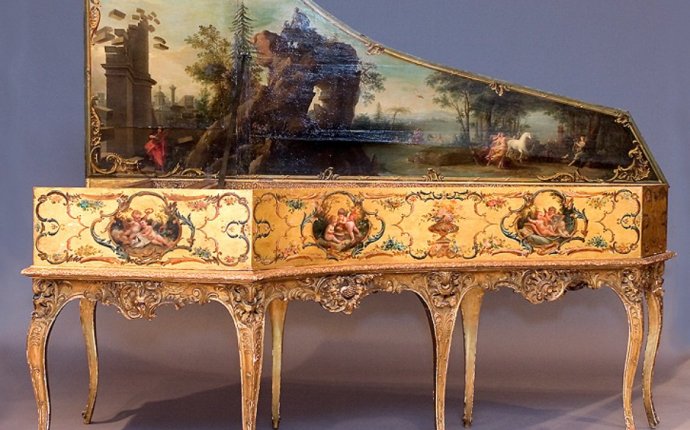
Instruments from the Baroque period
Arts and Humanities Through the Eras
COPYRIGHT 2005 The Gale Group, Inc.
Idiomatic Composition.
Baroque composers often wrote music for particular instruments, taking into account their special sounds and qualities—that is, their tonal and harmonic possibilities, their distinctive voice, and range of pitches—to produce works that often have been described as "idiomatic." Composers became increasingly prescriptive about the instruments upon which their music should be played. Hence, the music of the Baroque era differed fundamentally from the medieval and Renaissance periods that had preceded it. In those earlier eras the choice of particular instruments had largely been left up to musicians themselves, who were free to choose from all the available possibilities to perform a particular piece. Many Baroque composers, by contrast, became especially famous for their writing for specific instruments. Domenico Scarlatti (1685–1757), for example, was widely known for his compositions for the harpsichord. Scarlatti himself was a virtuoso keyboard player, and his published works for the harpsichord became widely used exercises for students. These works showed off the full range of tonal possibilities and effects that could be gleaned from the best playing on the instrument, and they influenced many later composers' works for the harpsichord. What Scarlatti helped to accomplish for the harpsichord, Dietrich Buxtehude (1637–1707) and Johann Sebastian Bach (1685–1750) came to do for the pipe organ, creating works that have remained since their time among the most brilliant and accomplished compositions for that instrument. Numerous examples might be cited of new repertory that came into being during the Baroque, which was written for the specific abilities woodwind and string instruments now offered.
Keyboard Instruments.
By the seventeenth century composers had a number of different kinds of keyboard instruments to choose from when they wrote their works, and each of these had its own distinctive characteristics. The chief keyboard instruments of the Baroque were the organ, harpsichord, clavichord, and at the end of the period, the pianoforte. Although the organ is played by virtue of a keyboard, its sounds are produced by wind rushing through pipes. Among keyboard instruments it is unique in its ability to sustain a particular tone so long as the organist holds down a particular key. The organ can also make a wide variety of sounds, depending upon the construction of its pipes. Baroque organs steadily grew in size and complexity and they came to offer the possibility of playing an independent musical line with the feet on a pedalboard. Use of the pedals was particularly advanced in the Baroque period in northern Germany, and this region of Europe had developed a number of organ virtuosi, including Buxtehude and Bach, by the early eighteenth century. Often a town's pipe organ was, like its clock or glockenspiel, a matter of intense pride, and the instrument was added onto, remodeled, and modernized to fit the changing tastes of the era. Figures like Bach supplemented their incomes by evaluating the organs of other churches, and suggesting to town and parish councils ways in which the instrument might be improved. Massive pipe organs, though, were hardly household instruments, although smaller scaled units were sometimes found in wealthy homes and the palaces of the nobility. By and large, the chief domestic keyboard instruments of the era were the clavichord and harpsichord, which produced their sounds by striking or plucking strings. Musicians and composers often used the clavichord, considerably smaller and less expensive than the harpsichord, as a practice instrument. It is a difficult instrument to play since it requires strength and dexterity of hand, and produces a much quieter sound than a modern piano. Later Baroque musicians often relied upon it to build technical strengths that they could then apply to harpsichord and pianoforte playing. Unlike the harpsichord, the instrument provided a considerable dynamic range, and when struck vigorously it produced a much louder tone. Few Baroque composers, though, exploited the instrument's strengths, with the exception of Carl Philipp Emanuel Bach (1714–1788), one of Johann Sebastian's sons, who wrote a number of works for the clavichord in the later eighteenth century. The harpsichord was more popular with composers, and since the mid-seventeenth century this instrument had been undergoing constant technical innovations. At that time the harpsichord had become popular as an instrument for solo performance and for accompanying singers. It was favored in part because its sound was not unlike that of the lute, which in both the Renaissance and early Baroque periods was the most common domestic instrument in use throughout Europe. Like the lute, many keys could be struck on the harpsichord simultaneously to play chords, and for this reason the instrument played a key role in many of the orchestras and ensembles of the Baroque era. The harpsichord, like the organ, provided a ready source of continuous accompaniment to other instruments. It was also widely used in the theaters of the time as the instrument favored to accompany operatic recitatives. By the mid-eighteenth century, however, its limited dynamic range—that is, its inability to play loud and soft—meant that it was to become increasingly replaced by the fortepiano once such dynamic range became a prominent feature of composition and performance. A relative newcomer among the keyboard instruments of Europe, the fortepiano was invented in the early years of the eighteenth century. Rather than its strings being plucked, they were struck by hammers, and a player was thus able to produce great dynamic contrasts. It was for this reason that that instrument was originally known as the clavicembalo col piano e forte, or a "loud and soft harpsichord." Few Baroque-era composers explicitly stipulated the pianoforte's use in their compositions, since its popularity did not gain ground until the second half of the eighteenth century.









